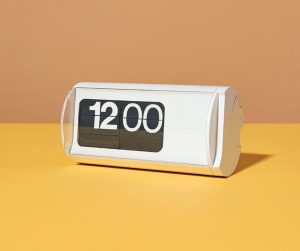“Anyone who travels is familiar with the large flip-board displays indicating the gate of your plane, train or bus. Their distinctive shuffling sound, which sends travelers scurrying like a well-orchestrated flash mob, is so synonymous with departure that when Boston’s North Station upgraded its boards to LED displays, they were programmed to emit the familiar clicketyclack, as much for nostalgia as for necessity: How else to get passengers to look up from their phones?
Less familiar — unknown, more likely — is the man responsible for effectively conducting this movement of millions of people for the past 60 years, Remigio Solari. His family’s business had been making clocks for towers in the Dolomites of Northern Italy since 1725. You could say the movement of time was in his blood, or perhaps he had too much of it on his hands, but in the late 1940s, the self-taught engineer had a breakthrough: Rather than hands that move around fixed numbers on a dial, he inscribed the numbers on metal flaps that rotated around a wheel. It was a revelation in terms of clarity, particularly when standing at a distance. In 1956, the first “Solari board” was installed in a train station in Belgium, becoming the worldwide standard for rail and airway travel soon after.
Remigio died in 1957, but his brother Fermo continued his work. With the architect Gino Valle, the Solari company introduced a small electromechanical flip clock, the Cifra 5. While this model won the Compasso d’Oro award at Milan’s International Furniture Fair, it was the Cifra 3, designed in the mid-’60s, which had families everywhere replacing analog clocks with the new technology. The minimalist packaging — a glossy thermoplastic cylinder to accommodate the flaps’ rotation — and the crisp sans serif digits designed by Massimo Vignelli, were soon copied by everyone from General Electric to Hitachi.
I got my own Sony knockoff in 1972. It was the first piece of technology that I fetishized and had to have. Owning it felt somehow like I was invested in the future, or at least a part of it. Later I discovered the source of my so-called digital clock, the Cifra 3, at the Museum of Modern Art in New York, which had added it to its collection in 1966, because it was, and is, “the purest expression of industrial design,” according to senior curator Paola Antonelli.
Then I had to have the real thing and found I wasn’t alone. The clock, discontinued in 1989, had an almost cultlike following, fueling a secondary market among collectors. Solari’s new owners took note and last year put the Cifra 3 back into production at their factory in Udine, where employees continue to assemble it by hand. I was able to get one of the first reissues in Europe (it becomes available in the U.S. this fall), and it now sits, not by my bedside, but on the mantel in my living room, next to other beautiful items, like a midcentury Lucy Rie vase.
Although the Cifra 3 can’t compete with the Solari boards in terms of the number of customers served (the company estimates that it has helped 5.5 billion people navigate trips), it is — like its descendant, the iPod — a potent example of how design can elevate technology.”

